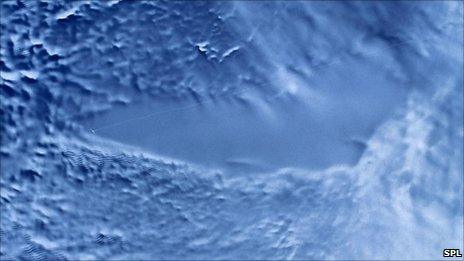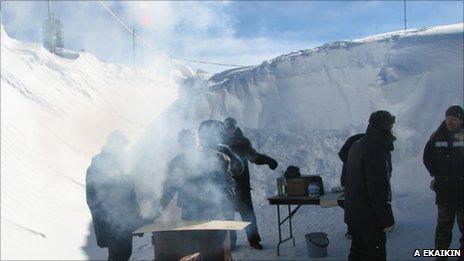Lake Vostok drilling in Antarctic 'running out of time'
- Published

The first satellite images of Lake Vostok were obtained in the 1990s
With only about 50m left to drill, time is running out for the Russian scientists hoping to drill into Vostok - the world's most enigmatic lake.
Vostok is a sub-glacial lake in Antarctica, hidden some 4,000m (13,000ft) beneath the ice sheet.
With the Antarctic summer almost over, temperatures will soon begin to plummet; they can go as low as -80C.
Scientists will leave the remote base on 6 February, when conditions are still mild enough for a plane to land.
The team has been drilling non-stop for weeks.
"It's like working on an alien planet where no one has been before," Valery Lukin, the deputy head of Russia's Arctic and Antarctic Research Institute (AARI) in St Petersburg, which oversees the project, told BBC News.
"We don't know what awaits us down there," he said, adding that personnel at the station have been working shifts, drilling 24 hours a day.

Microorganisms have already been found in the lake's frozen water
But some experts remain concerned that probing the lake's water - thought by some to be isolated from everything else on Earth - could contaminate the pristine ecosystem and cause irreversible damage.
The sub-glacial lake is located underneath the remote Vostok station in Antarctica.
Overlaid by nearly 4km of ice, it has been isolated from the rest of the world for millions of years. Some scientists think the ice cap above and at the edges has created a hydrostatic seal with the surface, preventing lake water from escaping or anything else from getting inside.
And if the Russian team gets through to the pristine waters, they hope to encounter life forms that have never been seen.
Astonishing discovery
It was at the Vostok station that the coldest temperature ever found on Earth (-89°C) was recorded on 21 July 1983.
Normally, water in such extreme conditions exists only in one state: ice. And when, in the 1970s British scientists in Antarctica received strange radar readings at the site, the presence of a liquid, freshwater lake below the ice did not instantly spring to mind.
It was not until 1996 that the discovery was formally acknowledged, after satellites sent in the images outlining the lake's contours.
Space radar revealed that the sub-glacial body of fresh water was one of the largest lakes in the world - and one of some 150 subglacial lakes in Antarctica.
At 10,000 square km and with depths reaching 800m, it is similar to Lake Baikal in Siberia or Lake Ontario in North America.
Since the lake has remained sealed off from the rest of the world, scientists estimate that conditions in it have probably remained unchanged for some 15 million years.
For liquid water to exist in Antarctica, glaciologists suggest that the ice cap serves as a giant insulating blanket, able to capture the Earth's geothermal heat to melt the bottom of the ice sheet.
Eager to explore the ancient lake, scientists started drilling and managed to go as deep as about 3,600m - but when the untouched waters were only some 130m away, in 1998, the project ground to a halt.

Antarctica's Vostok station was built in 1956
"We had to stop because of the concerns of possible contamination of the lake," explained Alexey Ekaikin, a member of the current expedition, who spoke to the BBC Russian Service from Vostok station.
He said that drilling was resumed in 2004, when the team came up with new, ecologically safe methods of probing the lake.
In November 2010, the scientists submitted a final environmental evaluation of the project to the Antarctic Treaty's environmental protection committee and were given the go-ahead to sample the ancient waters.
They said that instead of drilling into the lake, they would go down until a sensor on the drill detects free water.
Then they would take the drill out without going any further and adjust the pressure so that instead of any liquid in the borehole falling down into the lake, water in the lake would be sucked up.
Then the drill would be taken away and left for quite some time to freeze, creating a plug of frozen ice in the bottom of the hole.
Finally, next season, the team would drill down again to take a sample of that ice and analyse it.
But the work has not been going very smoothly, being repeatedly delayed because of technical difficulties.

In the summer season (Dec to Feb), air temperature is relatively mild, about -30C, but in the winter it can plummet to -80C
"Up until three km down, drilling is usually relatively easy - it has been done in Greenland and here in Antarctica. But after three km and as we near the bottom [of the ice sheet], the ice temperature gets very close to the ice melting point, and all sorts of problems begin," said Dr Ekaikin.
Dr Lukin added that additional difficulties arise from the changing structure of the ice - after about 3,600m, it is pure frozen lake water, composed of huge round monocrystals of a metre or more in diameter and as hard as glass.
That is why for the past few weeks, the team had been advancing at a snail's pace - about 1.6m a day.
They have already reached the 3,700m mark and have just some 50m more to go.
Dr Ekaikin said that having analysed the ice cores obtained so far, the scientists have already discovered some bacteria that are likely to be living at the bottom of the lake, where the water is warmer because of the heat coming from the Earth.
Contamination concerns
Besides possibly discovering new microorganisms, sampling the waters could also move us a step closer to the understanding of similar glacial conditions at one of Jupiter's moons, Europa.
Its surface, researchers suspect, is covered by a huge ocean, hidden within a thick shell of ice.

The ice is extremely hard, which has caused the team problems while drilling
Despite all the precautions, some international observers still dub the project a threat to the ancient sub-glacial lake.
"It's probably almost impossible to make something absolutely, utterly and totally clean," said Dr Andy Smith, a glaciologist at the British Antarctic Survey.
"It's worth [sampling the waters], as even though originally it seemed a really wild thing to expect, there will be life there - anywhere we go on the planet where there's an extreme environment, we always find life.
"But we have to make a huge effort not to spoil the environment by being interested in it," he added.
But the Russians working in Antarctica believe that the risks are virtually non existent and that the possibility of a great discovery makes it entirely worthwhile.
In 2006, researchers reported evidence for a network of rivers under the ice which connect Antarctica's sub-glacial lakes. Some scientists think this could spell trouble for the prospects of finding microbial life that has evolved "independently".
Nevertheless, some of those on the team working at Lake Vostok have been waiting for a eureka moment for decades, and have been coming to the base to drill since the discovery of the lake in the 1970s.
Now they are hoping the technology will not fail them and they will be able to reach the waters before the season ends on 6 February.

The scientists say that at the base, there are only two colours: white and blue; but the scenery is still breathtaking
Because if not, they will have to stay patient for yet another long year.
- Published28 January 2011